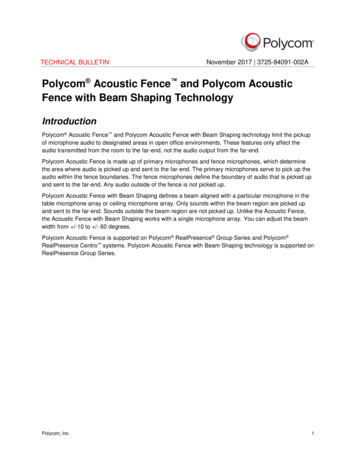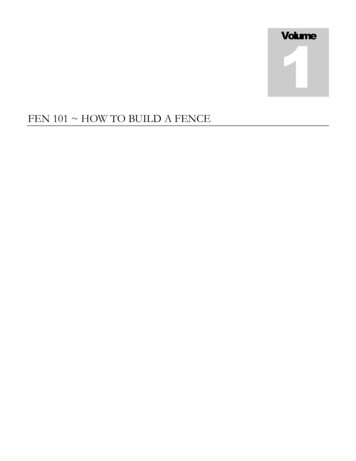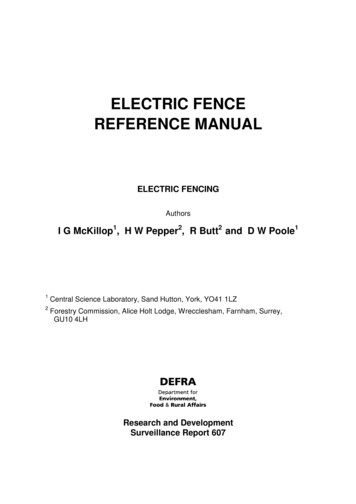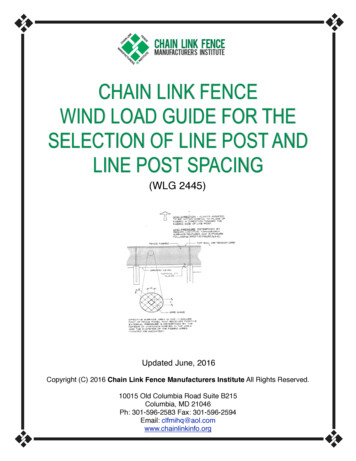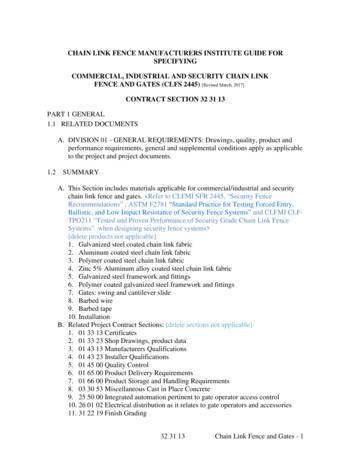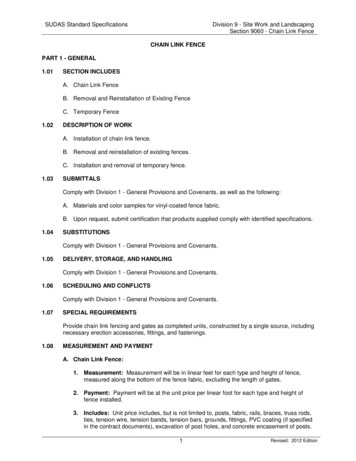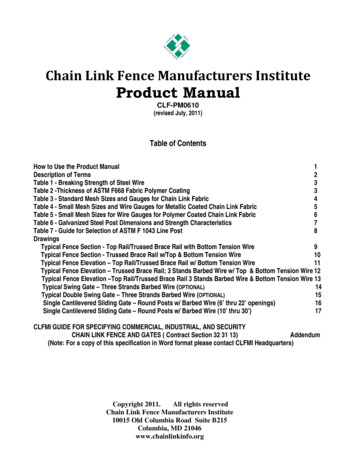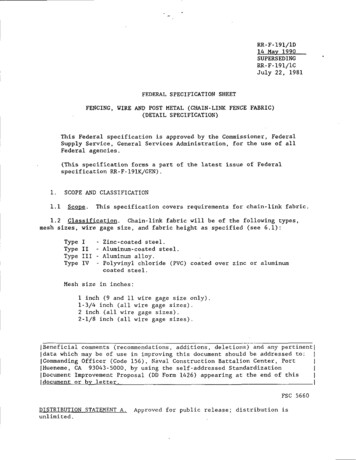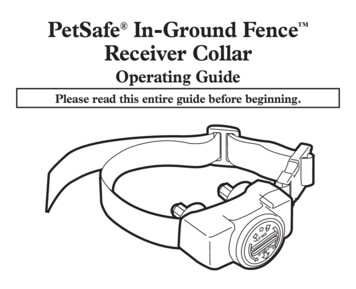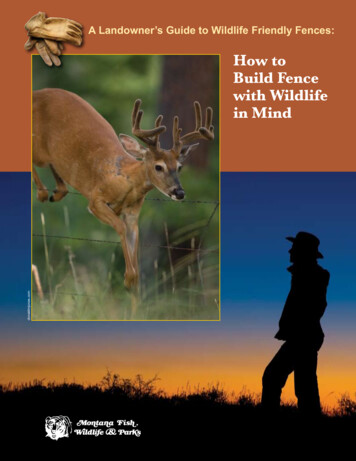
Transcription
A Landowner’s Guide to Wildlife Friendly Fences:donaldmjones.comHow toBuild Fencewith Wildlifein MindLandowner/Wildlife Resource ProgramField Services DivisionMontana Fish, Wildlife and ParksHelena, MT2008
FWPAcknowledgementsAuthorMany land and wildlife specialists offeredChristine Paige, Ravenworks Ecology,their insights to this guide. Joe Weigand,Stevensville, MT. chrispaige@gmail.com.Montana Fish, Wildlife and ParksLandowner/Wildlife Resource Specialist,provided funding and guidance for theproject, as well as expertise from testingvarious designs with landowners. BryceAndrews conducted interviews and wroteGraphic DesignSeiler Design & Advertising, Missoula,MT. nadesign@montana.com.IllustrationsE.R Jenne Illustration, Missoula, MT.the profiles detailing landowner andedjenne@earthlink.net.ranch manager experiences. FWPCitationbiologist Jay Kolbe provided fencePaige, C. 2008. A Landowner’s Guidespecifications, photos and otherto Wildlife Friendly Fences. Landowner/invaluable contributions to the project.Wildlife Resource Program, MontanaRalph Burchenal, John Kountz, MarinaFish, Wildlife and Parks, Helena, MT.Smith, Wayne Ternes, Juanita Vero,44 pp.the Anaconda Gun Club and the RockyMountain Elk Foundation partnered withMontana Fish, Wildlife and Parks to testfence designs in various livestock andwildlife situations and provided invaluableinsights and suggestions. Many biologistsand resource professionals around theU.S. provided references and insightsfrom their experience via email andlistservs – thank you all.
donaldmjones.comTable of ContentsWildlife and Fences. . . . . . . . . . . . . . . . . . . . . . . . . . . . . . . . . . . . . . . 2Problem Fences . . . . . . . . . . . . . . . . . . . . . . . . . . . . . . . . . . . . . . . . . 3Wildlife Friendly Fences . . . . . . . . . . . . . . . . . . . . . . . . . . . . . . . . . . 6Getting Started . . . . . . . . . . . . . . . . . . . . . . . . . . . . . . . . . . . . . . 6Fence and Crossing Placement . . . . . . . . . . . . . . . . . . . . . . . . . 6Friendly Designs. . . . . . . . . . . . . . . . . . . . . . . . . . . . . . . . . . . . . . . . . 8Visibility . . . . . . . . . . . . . . . . . . . . . . . . . . . . . . . . . . . . . . . . . . . . 9Sites with Low or Seasonal Livestock Use . . . . . . . . . . . . . . . . . 11Sites with High or Continuous Livestock Use . . . . . . . . . . . . . . . 17Openings, Crossings and Passes . . . . . . . . . . . . . . . . . . . . . . . . 23Remedies for Existing Fences . . . . . . . . . . . . . . . . . . . . . . . . . . . 32Fence Alternatives . . . . . . . . . . . . . . . . . . . . . . . . . . . . . . . . . . . . . 33If You Must Exclude . . . . . . . . . . . . . . . . . . . . . . . . . . . . . . . . . . . . 35Getting Help . . . . . . . . . . . . . . . . . . . . . . . . . . . . . . . . . . . . . . . . . . 40
Fences crisscross Montanalandscapes like countlessstrands of a spider’s web.Barbed-wire, woven-wire,jackleg and other fences defineand divide ranches and farms,outline property boundaries,enclose pastures and rangelands,and run for miles along highwayand road corridors. Yet fencescan be barriers and traps forwildlife, from big game animalsto birds, causing injury andunnecessary fatalities. Animaldamage to fences is also costlyand frustrating for landowners.FWPWildlife and FencesWe share our lands with a richand abundant array of wildlifein Montana – wildlife that musttravel across landscapes to findfood, shelter and water forsurvival. Too often, animals andbirds are injured or killed whenthey collide with fences or gettangled in wires. Most peoplewould prevent these needlessdeaths if only they knew how.Christine PaigeNot all fences are problemfences. By tailoring your fencedesign and placement, you canprevent injury to wild animalsand lessen wildlife damageto your fence. Many of thesemethods are low-cost or cansave you money in the long-runby reducing the need for fencerepair.
Problem FencesDeer, elk, moose, mountainsheep, and pronghorn are allcapable of jumping fences, butbarbed-wire can snag animalsand tangle legs, especially if wiresare loose or spaced too closelytogether. If animals can’t pull free,they die a slow and desperatedeath. Even when animals doclear fences, or crawl through orunder the strands, they often bearcountless scars from wire barbs.If woven wire is topped with oneor more strands of barbed-wire,the fence becomes a completebarrier, especially for fawns,calves, pronghorn and otheranimals that are incapable orunwilling to jump over such afence. Animals trying to leap awoven-wire/barbed-wire fence areeven more likely to tangle a legbetween the top barbed-wire andthe stiff woven wire.What kinds of fence causeproblems for wildlife?Fences that:are too high to jump;are too low to crawl under;have loose wires;have wires spaced too closelytogether;are difficult for fleeinganimals or birds to see;create a complete barrier.Christine PaigeSome fences, especially wovenwire, can be a complete barrier tofawns and calves even if adultscan still jump over. Separatedfrom their mothers, the youngsters curl up and die of starvation,stranded and unable to followthe herd. Woven wire can alsoblock animals, such as bears andbobcats, that are unable to leapfences and are too large to slipthrough.Top: A panicked deerlooks for a way througha barbed-wire fence.Above: A fence mess – adjacentlandowners erected two fences, creatinga nightmare tangle for wildlife.Christine PaigeChristine PaigeLeft: Pronghorn findit almost impossibleto cross woven wirefences topped withbarbed wire.
Problem FencesJackleg or buck and rail fencesare sometimes considered wildlifefriendly, but they are usually builttoo high, too wide and with railsplaced too closely together foranimals to cross or crawl through.The three-dimensional jacklegdesign is especially hard to leapover, and if jackleg is combinedwith woven or barbed-wire orplaced on steep terrain, it presents an almost complete barrier toungulates and other large animals.Jackleg fence also requires highmaintenance – the posts and railscan rot and collapse under snowloads and winds.Birds, too, collide with fences,breaking wings, impaling themselves on barbs, and tangling inwires. Large, low-flying birds suchas ducks, geese, cranes, swans,grouse, hawks and owls areespecially vulnerable. Waterfowl flyinto fences that run near or acrosswaterways, and low-flying hawksand owls may careen into fenceswhen swooping in on prey.12This peregrine falcon died when itcollided with a fence while diving onkilldeer. Many birds are vulnerable tofence collisions.4Chris MayneSwans and other waterfowl can bevictims of fences strung across or nearwaterways.Doug WoodMark Gocke3Steve PrimmAbove: After crossing a highway, a blackbear desperately searches for a waythrough a woven-wire fence, finallyclimbing a power pole to leap over. Left: This badly tangled pronghorn wasfortunately freed by the photographer,who was able to clip the wires.
Problem FencesOn average, one ungulate peryear was found tangled for every2.5 miles of fence. ost animals (69% of juvenilesMand 77% of adults) died bygetting caught in the top twowires while trying to jump afence.Woven-wire fence topped with asingle strand of barbed-wire wasthe most lethal fence type, as itmore easily snared and tangledlegs between the barbed-wire andrigid woven-wire.70% of all mortalities were onfences higher than 40”.Blocked and StrandedWhere ungulates were found deadnext to, but not in fences, onaverage one ungulate per yeardied for every 1.2 miles of fence.Randy GazdaSnared and EntangledMortalities peaked duringAugust, when fawns are weaned. 0% of these carcasses found9near fences were fawns lyingin a curled position – probablyseparated from their motherswhen they could not cross.Most of these indirect mortalitieswere found next to woven-wirefences.Bryce AndrewsRecently, researchers at UtahState University completed astudy of wildlife mortality alongmore than 600 miles of fences inthe rangelands of northeasternUtah and northwestern Colorado(Harrington 2005, Harrington andConover 2006). By repeatedlydriving and walking fencelines overtwo seasons, they tallied thenumber of mule deer, pronghornand elk carcasses they foundcaught in fences and lying next tofences. They also studied whichfence types caused the mostproblems. Here are their keyfindings:J uveniles are eight timesmore likely to die in fencesthan adults.Above: Elk, deer and other ungulatescan suffer a terrible death if their legstangle in fences. Landowners havethe sad and frustrating job of clearingout carcasses and repairing wildlifedamage to their fences.Rory KarhuHard NumbersLeft: Antlered animals can becomefatally tangled in poly rope fence andloose barbed wire. Maintaining fencetension and using high-tensile wirefor electric fences prevents suchtragedies.
Wildlife Friendly FencesWhen you design yourfence, consider:purpose of the fencetopography – hills, gullies,streams and wetlandsGetting Startedspecies of wildlife presentThe best situation for wildlifeis open habitat with no fencesat all. Where fence is necessary, less fence is better. To getstarted, consider your needs andcreate a plan.This guide will help you withdesigns that are wildlife friendly.You can tailor any of thesedesigns to your specific needs.But first consider these questions:1. What is the purpose of thefence? Do you need to mark aboundary? Deter trespass?Enclose or exclude livestock?If your fence is for livestock,what kind, in what seasons, andfor how long? Your purposeshould determine your fencedesign and placement.2. What is the topography?Are you fencing on hills, inrocky country where postscannot be driven, or near oracross streams or wetlands?Can you design your fenceto avoid topography traps forwildlife?daily or seasonal wildlifemovements in the areapresence of water, food andcover for wildlifepresence of young animals3. Which wildlife species are inyour area and may need tonegotiate the fence?4. What are the daily or seasonalwildlife movements in the area?Do animals calve or nestnearby?Fence and Crossing PlacementThe placement of fences isjust as important as the typeof fence used. Fencing need notrestrict wildlife movement everywhere on your property. Whereverpossible, design your fence toprovide wildlife free travel to important habitats and corridors, aswell as access to water. Wetlandsand riparian habitats are especially important for all wildlife.Watch for daily and seasonalwildlife movement patterns andlook for trails.gaps or lay-down sections forwildlife passage whereverlivestock are not present.Use special purpose fencing onlyin the areas needed, such aslivestock pastures, haystacks,gardens, orchards, yards, playareas, or kennels. Designproperty boundary fences sowildlife can easily cross, or withWork with your land’s topography. Swales, gullies, ridgesand stream corridors can funnelwildlife through an area – keepthese open to allow wildlifepassage and avoid topographytraps.Slope increases barrier75”62”50% slope42”0% slope 30% slope
Wildlife Friendly Fenceshaystackfencechildren’splay r fencewildlife access towater and travelcorridorlay-downfencePlace crossings, jumps, opengates and other wildlife openingsin appropriate locations. Deer, elkand pronghorn are more likely touse openings at fence cornersthan in the middle of a fence run,unless there is cover, habitator natural corridors or trails toattract them through. Intermittent openings should be placedwhere animals naturally travel: inriparian corridors, along gulliesand ridges, and on existing gametrails.A fence of any height is moredifficult to cross when placedacross a steep slope. As groundslope increases, the distancean animal must jump to clearthe fence increases considerably (See illustration at left). Forinstance, a 42” fence may bepassable on level ground, but aslope of only 10% increases theeffective fence height to 48.6”; aslope of 30% increases effectiveheight to 62”, and on a 50% slopeanimals encounter an obstacle75” high. Fences on steep slopesbecome nearly impossible foranimals to jump without injury.Tailor your fences to specific needs andallow wildlife access to water, importanthabitats, and travel corridors.Look for wildlife trails andwatch for seasonal patterns.Provide wildlife access toriparian habitats, waterholes and other high qualityhabitats.Provide passage alongswales, gullies, ridges andstream corridors. Use the appropriate fencedesign for each activity.On slopes and in naturaltravel corridors, plan forwildlife crossings.
Friendly DesignsThe ideal wildlife friendly fenceshould (1) allow relatively freepassage for animals to jump overand crawl under, and (2) be highlyvisible for both ungulates andbirds. You can combine or tailormany of the ideas presented herefor your specific situation.Fences should be low enoughfor adult animals to jump, preferably 40” or less, and the top twowires should be no less than 12”apart. Deer and elk easily tangletheir back legs if the top wires arecloser together. The bottom wireor rail should be high enough forpronghorn, calves and fawns tocrawl under, at least 18” from theground. Increasing visibilityusing a top rail, high-visibility wire,flagging or other visual markerscan help ungulates and birds,such as hawks, owls and swans,better navigate fences.Wildlife Friendly IdealWildlife friendly fences should be low enough for adult animals to jump,high enough for animals to crawl under, and minimize the chance oftangling. Montana Fish, Wildlife and Parks (FWP) recommends:A top wire or rail preferably no more than 40” above the ground, andabsolutely no more than 4
biologist Jay Kolbe provided fence specifications, photos and other to Wildlife Friendly Fences. Landowner/ invaluable contributions to the project. Ralph Burchenal, John Kountz, Marina Smith, Wayne Ternes, Juanita Vero, the Anaconda Gun Club and the Rocky Mountain Elk Foundation partnered with Montana Fish, Wildlife and Parks to test fence designs in various livestock and wildlife situations .
